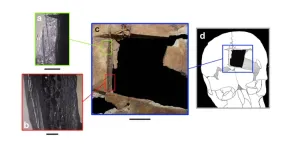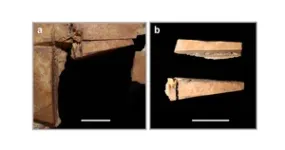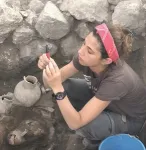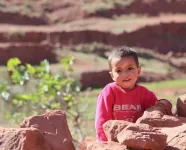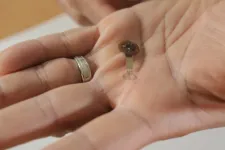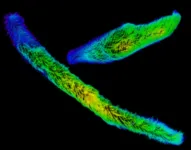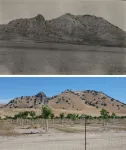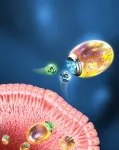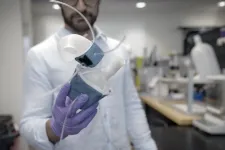(Press-News.org) PROVIDENCE, R.I. [Brown University] — Archaeologists know that people have practiced cranial trephination, a medical procedure that involves cutting a hole in the skull, for thousands of years. They’ve turned up evidence that ancient civilizations across the globe, from South America to Africa and beyond, performed the surgery.
Now, thanks to a recent excavation at the ancient city of Megiddo, Israel, there’s new evidence that one particular type of trephination dates back to at least the late Bronze Age.
Rachel Kalisher, a Ph.D. candidate at Brown University’s Joukowsky Institute for Archaeology and the Ancient World, led an analysis of the excavated remains of two upper-class brothers who lived in Megiddo around the 15th century B.C. She found that not long before one of the brothers died, he had undergone a specific type of cranial surgery called angular notched trephination. The procedure involves cutting the scalp, using an instrument with a sharp beveled edge to carve four intersecting lines in the skull, and using leverage to make a square-shaped hole.
Kalisher said the trephination is the earliest example of its kind found in the Ancient Near East.
“We have evidence that trephination has been this universal, widespread type of surgery for thousands of years,” Kalisher said. “But in the Near East, we don’t see it so often — there are only about a dozen examples of trephination in this entire region. My hope is that adding more examples to the scholarly record will deepen our field’s understanding of medical care and cultural dynamics in ancient cities in this area.”
Kalisher’s analysis, written in collaboration with scholars in New York, Austria and Israel, was published on Wednesday, Feb. 22, in PLOS ONE.
Two brothers, up close
Israel Finkelstein, who co-authored the study and serves as director of the School of Archaeology and Maritime Cultures at the University of Haifa, said that 4,000 years ago, Megiddo stood at and controlled part of the Via Maris, an important land route that connected Egypt, Syria, Mesopotamia and Anatolia. As a result, the city had become one of the wealthiest and most cosmopolitan cities in the region by about the 19th century B.C., with an impressive skyline of palaces, temples, fortifications and gates.
“It’s hard to overstate Megiddo’s cultural and economic importance in the late Bronze Age,” Finkelstein said.
According to Kalisher, the two brothers whose bones she analyzed came from a domestic area directly adjacent to Megiddo’s late Bronze Age palace, suggesting that the pair were elite members of society and possibly even royals themselves. Many other facts bear that out: The brothers were buried with fine Cypriot pottery and other valuable possessions, and as the trephination demonstrates, they received treatment that likely wouldn’t have been accessible to most citizens of Megiddo.
“These brothers were obviously living with some pretty intense pathological circumstances that, in this time, would have been tough to endure without wealth and status,” Kalisher said. “If you’re elite, maybe you don’t have to work as much. If you’re elite, maybe you can eat a special diet. If you’re elite, maybe you’re able to survive a severe illness longer because you have access to care.”
In her analysis, Kalisher spotted several skeletal abnormalities in both brothers. The older brother had an additional cranial suture and an extra molar in one corner of his mouth, suggesting he may have had a congenital syndrome such as Cleidocranial dysplasia. Both of the brothers’ bones show minor evidence of sustained iron deficiency anemia in childhood, which could have impacted their development.
Those developmental irregularities could explain why the brothers died young, one in his teens or early 20s and the other sometime between his 20s and 40s. But Kalisher said it’s more likely that the two ultimately succumbed to an infectious disease. A third of one brother’s skeleton, and half of the other brother’s, shows porosity, legions and signs of previous inflammation in the membrane covering the bones — which together suggest they had systemic, sustained cases of an infectious disease like tuberculosis or leprosy.
Kalisher said that while some skeletal evidence points to leprosy, it’s tough to deduce cases of leprosy using bones alone. She’s currently working with researchers at Germany’s Max Planck Institute for Evolutionary Anthropology to conduct DNA analyses of specific lesions in the bones. If they find bacterial DNA consistent with leprosy, these brothers will be among the earliest documented examples of leprosy in the world.
“Leprosy can spread within family units, not just because of the close proximity but also because your susceptibility to the disease is influenced by your genetic landscape,” Kalisher said. “At the same time, leprosy is hard to identify because it affects the bones in stages, which might not happen in the same order or with the same severity for everyone. It’s hard for us to say for sure whether these brothers had leprosy or some other infectious disease.”
It’s also difficult to know, Kalisher said, whether it was the disease, the congenital conditions or something else that prompted one brother to undergo cranial surgery. But there’s one thing she does know: If the angular notched trephination was meant to keep him alive, it didn’t succeed. He died shortly after the surgery — within days, hours or perhaps even minutes.
Digging into medical history
Despite all the evidence of trephination uncovered over the last 200 years, Kalisher said, there’s still much archaeologists don’t know. It’s not clear, for example, why some trephinations are round — suggesting the use of some sort of analog drill — and some are square or triangular. Nor is it clear how common the procedure was in each region, or what ancient peoples were even trying to treat. (Doctors today perform a similar procedure, called a craniotomy, to relieve pressure in the brain.) Kalisher is pursuing a follow-up research project that will investigate trephination across multiple regions and time periods, which she hopes will shed more light on ancient medical practices.
“You have to be in a pretty dire place to have a hole cut in your head,” Kalisher said. “I’m interested in what we can learn from looking across the scientific literature at every example of trephination in antiquity, comparing and contrasting the circumstances of each person who had the surgery done.”
Aside from enriching colleagues’ understanding of early trephinations, Kalisher said she hopes her analysis also shows the general public that ancient societies didn’t necessarily live by “survival of the fittest” principles, as many might imagine.
“In antiquity, there was a lot more tolerance and a lot more care than people might think,” Kalisher said. “We have evidence literally from the time of Neanderthals that people have provided care for one another, even in challenging circumstances. I’m not trying to say it was all kumbaya — there were sex- and class-based divisions. But in the past, people were still people.”
In addition to Kalisher and Finkelstein, other authors of the analysis included Melissa Cradic from the University at Albany; Matthew Adams of the W.F. Albright Institute for Archaeological Research in Jerusalem; and Mario Martin from the University of Haifa and University of Innsbruck. The study’s associated excavation was funded by the Shmunis Family Foundation.
END
Archaeologists uncover early evidence of brain surgery in Ancient Near East
A recent excavation in Megiddo, Israel, unearthed the earliest example of a particular type of cranial surgery in the Ancient Near East — and potentially one of the oldest examples of leprosy in the world.
2023-02-22
ELSE PRESS RELEASES FROM THIS DATE:
Keeping babies alive will lower population growth – new research
2023-02-22
Keeping babies alive will lower population growth – new research
New research showing high infant mortality rates are contributing to an incessant rise of the global human population supports arguments for greater access to contraception and family planning in low- and middle-income nations.
In an article published in PLOS ONE, research led by Professor Corey Bradshaw, Matthew Flinders Professor of Global Ecology from Flinders University and Peter Le Souëf, Professor of Paediatrics from The University of Western Australia has found that with higher baby death rates and larger household sizes (as an indicator of population density), ...
First transient electronic bandage speeds healing by 30%
2023-02-22
Wireless, battery-free bandage delivers electrical signals to help wounds heal
Bandage monitors healing, streaming data in real time to a smartphone or tablet
After healing is complete, bandage and electronics harmlessly absorb into the body
EVANSTON, Ill. — Northwestern University researchers have developed a first-of-its-kind small, flexible, stretchable bandage that accelerates healing by delivering electrotherapy directly to the wound site.
In an animal study, the new bandage healed ...
Giant proteins in a giant cell: Molecular basis behind fastest biological movement of single-celled eukaryotes
2023-02-22
In his famous letter to the Royal Society dated Oct. 9, 1676, Antonie van Leeuwenhoek described a single-celled eukaryote (Vorticella) and its fascinating ultrafast cell contraction as the first set of discoveries. This kind of ultrafast cell contraction triggered by a Ca2+-dependent mechanism is distinct from the adenosine triphosphate (ATP)-dependent mechanisms found in actin-myosin and dynein/kinesin-tubulin systems.
Spirostomum, is a genus of millimeter-scale single-celled protists that are known for their incredibly rapid movement like Vorticella. They are capable ...
Bow-and-arrow, technology of the first modern humans in Europe 54,000 years ago at Mandrin, France
2023-02-22
If the emergence of mechanically propelled weapons in prehistory is commonly perceived as one of the hallmarks of the advance of modern human populations into the European continent, the existence of archery has always been more difficult to trace. The recognition of these technologies in the European Upper Paleolithic has been hampered by ballistic overlaps between weapons projected with a thruster or a bow. Archery technologies are essentially based on the use of perishable materials; wood, fibers, leather, resins, and sinew, which are rarely preserved in European Paleolithic sites and make archaeological recognition ...
Climate change, urbanization drive major declines in L.A.’s birds
2023-02-22
Berkeley — Climate change isn’t the only threat facing California’s birds. Over the course of the 20th century, urban sprawl and agricultural development have dramatically changed the landscape of the state, forcing many native species to adapt to new and unfamiliar habitats.
In a new study, biologists at the University of California, Berkeley, use current and historical bird surveys to reveal how land use change has amplified — and in some cases mitigated — the impacts of climate ...
Twin-bioengine self-adaptive micro/nanorobots developed for gastrointestinal inflammation therapy
2023-02-22
Micro/nanorobots with self-propelling and -navigating capabilities have attracted extensive attention in drug delivery and therapy owing to their controllable locomotion in hard-to-reach body tissues.
However, developing self-adaptive micro/nanorobots that can adjust their driving mechanisms across multiple biological barriers to reach distant lesions is still a challenge.
Recently, a research team led by Prof. CAI Lintao from the Shenzhen Institute of Advanced Technology (SIAT) of the Chinese Academy ...
Custom, 3D-printed heart replicas look and pump just like the real thing
2023-02-22
No two hearts beat alike. The size and shape of the the heart can vary from one person to the next. These differences can be particularly pronounced for people living with heart disease, as their hearts and major vessels work harder to overcome any compromised function.
MIT engineers are hoping to help doctors tailor treatments to patients’ specific heart form and function, with a custom robotic heart. The team has developed a procedure to 3D print a soft and flexible replica of a patient’s heart. They can then ...
Professor Guido Kroemer will inaugurate Redox Medicine 2023 by Highlighting the Hallmarks of Aging & Redox Medicine
2023-02-22
The 25th International Conference on Redox Medicine, on June 21-23 in Paris, will revolutionize tomorrow’s medicine through redox. The translation of basic knowledge of redox into molecular medicine will be extensively discussed.
Prof. Guido Kroemer from the Université de Paris Cité, Hôpital Européen George Pompidou - AP-HP, is the key note speaker for this year. It is a great opportunity to share with Guido Kroemer his favorite topics and to have a unique moment of exchange with him.
Hallmarks of Aging & Redox Medicine: An Expanding Universe
Prof. Kroemer will highlight the “hallmarks of ageing: genomic instability, ...
WVU physicists give the first law of thermodynamics a makeover
2023-02-22
West Virginia University physicists have made a breakthrough on an age-old limitation of the first law of thermodynamics.
Paul Cassak, professor and associate director of the Center for KINETIC Plasma Physics, and graduate research assistant Hasan Barbhuiya, both in the Department of Physics and Astronomy, are studying how energy gets converted in superheated plasmas in space. Their findings, funded by a grant from the National Science Foundation and published in the Physical Review Letters journal, will revamp ...
Yeast used in production of cachaça can prevent asthma, study shows
2023-02-22
A daily dose of a strain of brewer’s yeast used to produce cachaça (distilled spirit made from fermented sugarcane juice) can act as a preventive against asthma, according to a Brazilian study involving male mice. The results are reported in an article published in the journal Probiotics and Antimicrobial Proteins. The authors are researchers at the University of São Paulo (USP) and the Federal University of Minas Gerais (UFMG). The yeast strain used in the study was Saccharomyces cerevisiae UFMG A-905.
Asthma is a common lung condition that causes breathing difficulties. It ...
LAST 30 PRESS RELEASES:
Pandemic ‘beneath the surface’ has been quietly wiping out sea urchins around the world
Tea linked to stronger bones in older women, while coffee may pose risks
School feeding programs lead to modest but meaningful results
Researchers develop AI Tool to identify undiagnosed Alzheimer's cases while reducing disparities
Seaweed based carbon catalyst offers metal free solution for removing antibiotics from water
Simple organic additive supercharges UV treatment of “forever chemical” PFOA
£13m NHS bill for ‘mismanagement’ of menstrual bleeds
The Lancet Psychiatry: Slow tapering plus therapy most effective strategy for stopping antidepressants, finds major meta-analysis
Body image issues in adolescence linked to depression in adulthood
Child sexual exploitation and abuse online surges amid rapid tech change; new tool for preventing abuse unveiled for path forward
Dragon-slaying saints performed green-fingered medieval miracles, new study reveals
New research identifies shared genetic factors between addiction and educational attainment
Epilepsy can lead to earlier deaths in people with intellectual disabilities, study shows
Global study suggests the underlying problems of ECT patients are often ignored
Mapping ‘dark’ regions of the genome illuminates how cells respond to their environment
ECOG-ACRIN and Caris Life Sciences unveil first findings from a multi-year collaboration to advance AI-powered multimodal tools for breast cancer recurrence risk stratification
Satellite data helps UNM researchers map massive rupture of 2025 Myanmar earthquake
Twisting Spins: Florida State University researchers explore chemical boundaries to create new magnetic material
Mayo Clinic researchers find new hope for toughest myeloma through off-the-shelf immunotherapy
Cell-free DNA Could Detect Adverse Events from Immunotherapy
American College of Cardiology announces Fuster Prevention Forum
AAN issues new guideline for the management of functional seizures
Could GLP-1 drugs affect risk of epilepsy for people with diabetes?
New circoviruses discovered in pilot whales and orcas from the North Atlantic
Study finds increase in risk of binge drinking among 12th graders who use 2 or more cannabis products
New paper-based technology could transform cancer drug testing
Opioids: clarifying the concept of safe supply to save lives
New species of tiny pumpkin toadlet discovered in Brazil highlights need for conservation in the mountain forests of Serra do Quiriri
Reciprocity matters--people were more supportive of climate policies in their country if they believed other countries were making significant efforts themselves
Stanford Medicine study shows why mRNA-based COVID-19 vaccines can cause myocarditis
[Press-News.org] Archaeologists uncover early evidence of brain surgery in Ancient Near EastA recent excavation in Megiddo, Israel, unearthed the earliest example of a particular type of cranial surgery in the Ancient Near East — and potentially one of the oldest examples of leprosy in the world.
